|
Click the link if you wish to subscribe to our
Newsletter on our latest Jewelry Tutorials and Tool Tips . We send them out about 4 times a year. Over the years I have played
around with casting various objects When I was much younger,
I got an open order to cast a miniature rose in gold. I spent months
trying to cast the petals of a rose, and I never succeeded. Later, as my skills increased
in metal smithing, I realized that
making the petals out of solid stock and soldering the whole
lot together, would have been much easier. But casting
has always been an interest of mine. These include organic
and non-organic. The first I am going to show is some wood.
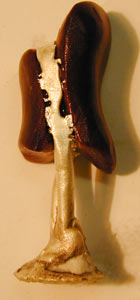
The
casting is rough. Bad. But it is round a piece of wood-Red
Ivory wood, to be exact. What I did was to carve a piece of
wood. Then I wound some round blue wax wire around the wood
and sprued it up. To those of you that are familiar with the
lost wax casting, there is an obvious problem. How to cast
without burning the wood away. Simple. I did not heat the
mould up to the normal temperature. Red ivory is a hard wood
that changes from a red to a brown at about 120C (personal
observation) So I kept the mould to about 90C for 5 hours.
That way the wood did not burn and the wax ran out and the
mould dried out. Then, using a spin casting machine, I
heated the metal up to casting temperature away from the
mould, and when it was ready, slid the mould forward and
cast.. I did this before with the metal as 'cool' as I
possibly could make it, but it did not work. This one I did
a bit hotter and, although it ain't no oil painting, it
still went all the way around. I have done this with stones
( zugalite) as well, and never succeeded. The metal
always tore apart.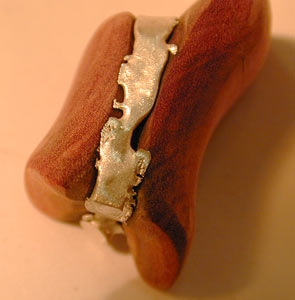
Wood sanded down and sprues cut off. No oil painting but a
solid band of metal around an organic piece of material. A
laser will do the job better, though----Next....
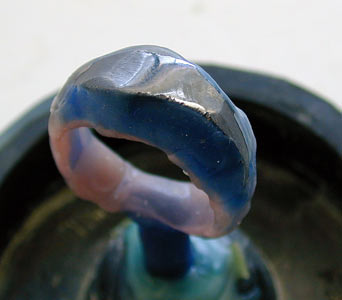
When I was in Tucson, I bought a piece of silicon that the
boffins use to make integrated chips on. So I rough-ground a
piece and took some pink and blue sprue wax and made the
above. I mean, they cook this stuff in major ovens with all
kinds of mean-bean gasses and witches brews, right? So what
can a lil' ol' casting oven do?
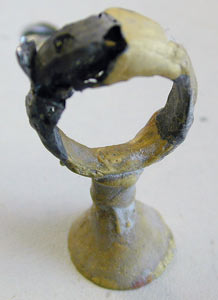
Ha! What do I know.. And being a touch over confident, I
used 18ct gold. Dang! I thought that, being silicon, it
would sort of look like a chrome insert

Patently not sellable.-------------Next....
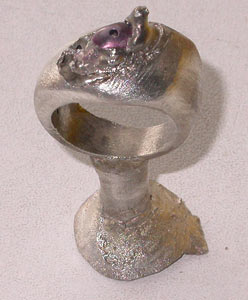
I
got clever. This time I cast with silver. I had some purple
gold made for me and I thought that a small sacrificial
piece would not mind to die for the god of Alchemy. And
verily, so it did.
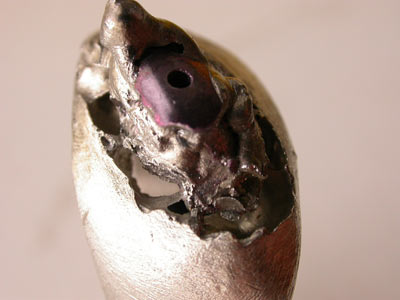
The hole in the middle was drilled in before by me. So
confident was I that I was going to succeed that I had
already planned to set a small diamond in
it.
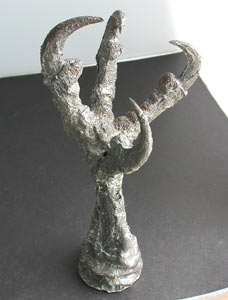
This is a claw from a Pel's
Fishing Owl.- Highly protected, CITES bird. How did I get
it? I used to stay in Botswana and as an avid birder and
bander, I had been monitoring a breeding pair of owls on the
banks of the Chobe river. This is the claw of (presumably)
the female. She was killed for bush medicine (muti) by one
of the local ethnic witch doctors.
Well, since she was dead, I
saved her claws and later cast them in silver. This cast
still has the bones in the middle of the piece. Bones do not
burn out in any reasonable time so, the silver flows over
them. The one I have finished off and the one pictured is as
it came out of the cast. It is the maximum my little machine
can handle at 450 grams. As you can imagine, not a very
sellable object.
Description of how to
tackle casting of insects in metal is another interesting project.
If you have any questions or wish to be notified of any new tutorials that are posted,
email me at hansmeevis.tutorials@gmail.com
Even though this is a free Tutorial, there remains a contractual obligation to the
intellectual property of Hans Meevis. It is not permitted to copy this tutorial content in any manner whatsoever,
be it in print or otherwise, nor be published online regardless as to whether a back link is included. |